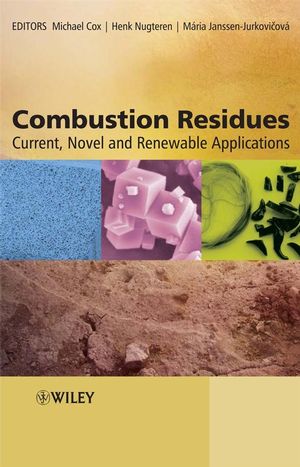Combustion Residues: Current, Novel and Renewable ApplicationsISBN: 978-0-470-09442-6
Hardcover
442 pages
May 2008
 |
||||||
List of Contributors.
1. The Current and Future Nature of Combustion Ashes (Alan Thompson).
1.1 Introduction.
1.2 Coal: the Principal Source of Combustion Residues.
1.3 Coal Ash: the Principal Combustion Residue.
1.4 Other Forms of Combustions.
1.5 Co-combustion Ashes.
1.6 Biomass and Waste.
1.7 Other Fuel Ashes.
1.8 Gasification.
1.9 Summary.
2. Established Uses of Combustion Residues (Michael Anderson (2.1–2.3, 2.7–2.9) and Rod Jones and Michael McCarthy (2.4–2.6).
2.1 Introduction.
2.2 Disposal Approaches for Three Prominent Combustion Residues.
2.3 PFA and its Agricultural Applications.
2.4 Uses of Fly Ash in Concrete.
2.5 Application of Fly Ash in Grouts.
2.6 Use of Ash in Fill and Pavement Construction.
2.7 PFA as an Ameliorator of Liquid and Solid Toxic Wastes.
2.8 Commercial Building Products Incorporating PFA.
2.9 The Use of PFA in Ceramic Products.
3. Limitations of Combustion Ashes: “From Threat to Profit'(Henk Nugteren).
3.1 Introduction.
3.2 Technical Quality.
3.3 Environmental Quality.
3.4 Health and Safety.
4. Novel Products and Applications with Combustion Residues.
4.1 Introduction (Henk Nugteren).
4.2 New Developments in Cement and Concrete Applications (Rod Jones and Michael McCarthy).
4.3 Combustion Residues in Heavy Clayware Building Products (Michael Anderson).
4.4 Zeolites (Xavier Querol and Natalie Moreno).
4.5 Reinforcing Materials: Fibres Containing Fly Ash (Flavio Cioffi).
4.6 Glass Polyalkenoate Cements (Ann Sullivan and Robert Hill).
4.7 Fire-resistant Materials (Constantino Fernández-Pereira and Luis Vilches Arenas).
4.8 Fly Ash as a Replacement for Mineral Fillers in the Polymer Industry (Henk Nugteren and Richard Kruger).
4.9 Geopolymers (Henk Nugteren).
4.10 Carbon Products (Henk Nugteren and Mercedes Maroto-Valer).
4.11 Recovery of Values from Combustion Ashes (Michael Cox).
5. Novel Products – from Concept to Market (Ian Barnes and Fritz Moedinger).
5.1 Introduction.
5.2 Novel Products – Basic Economic Considerations.
5.3 Specifications and Standards.
5.4 Legislation and Taxes.
5.5 Customer Acceptance.
5.6 Environmental Acceptance Schemes.
5.7 Concluding Remarks.
Index.



